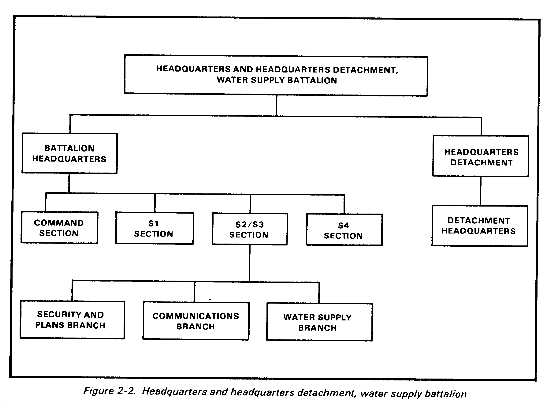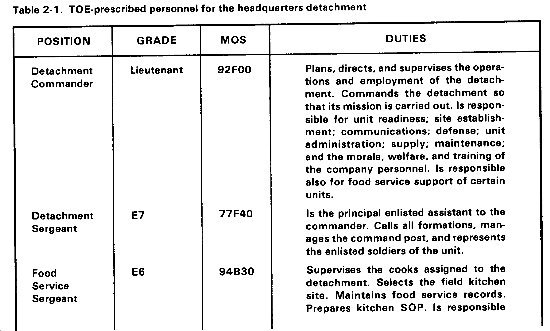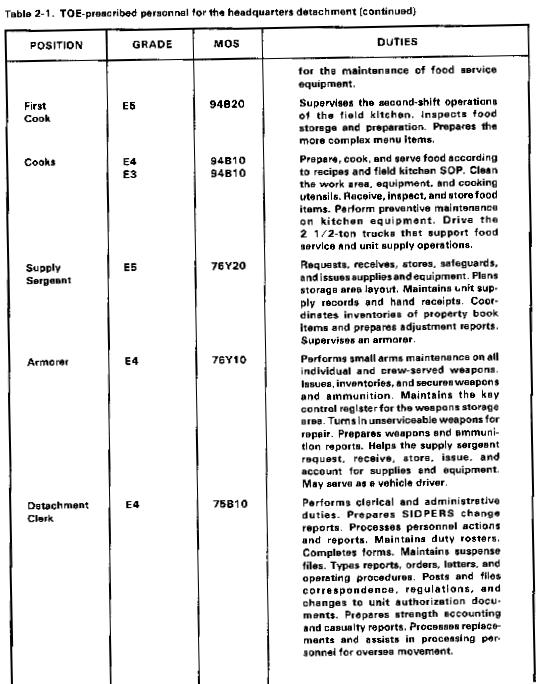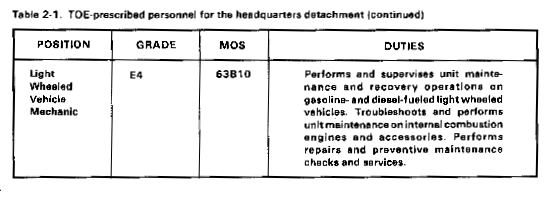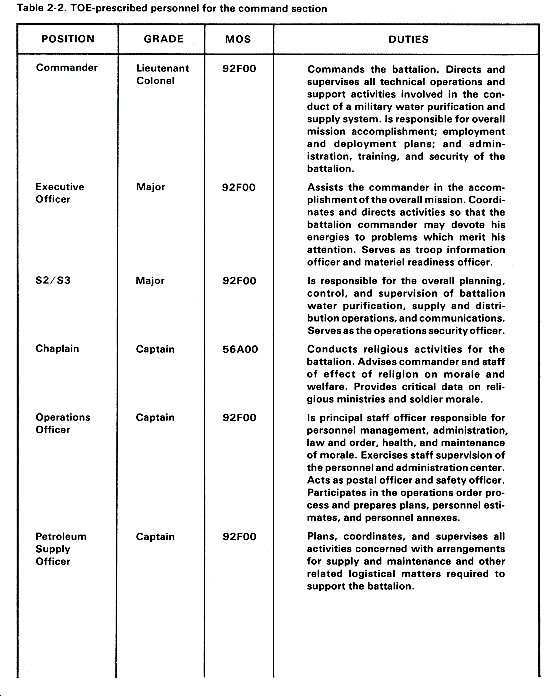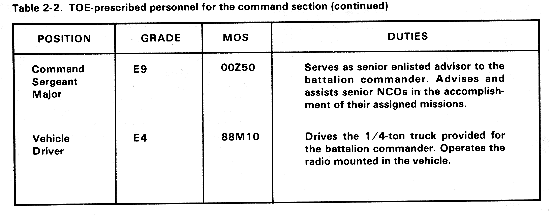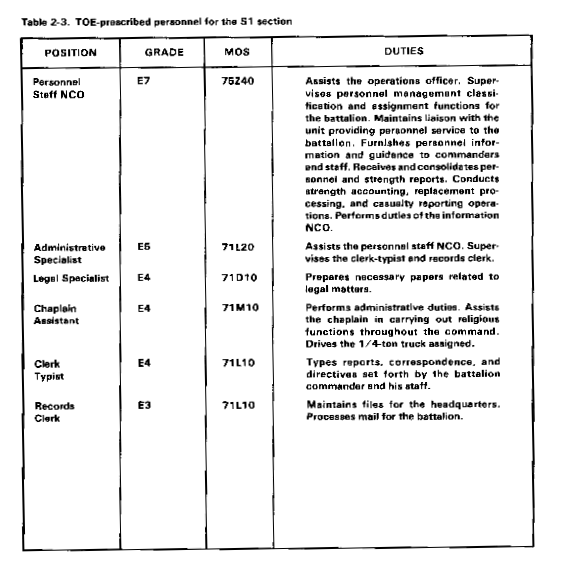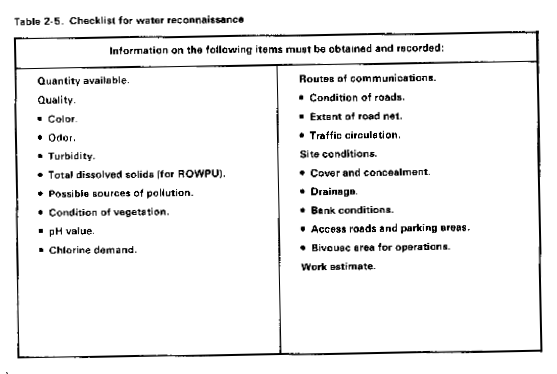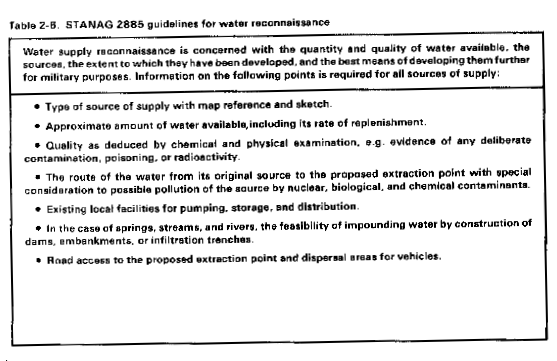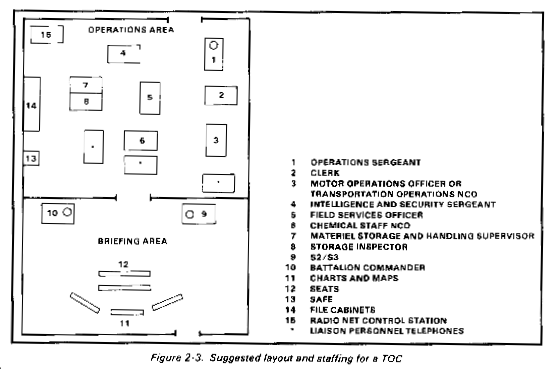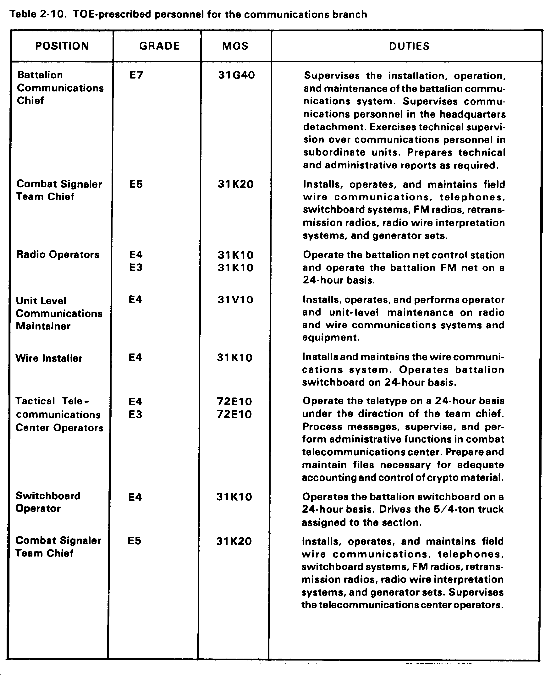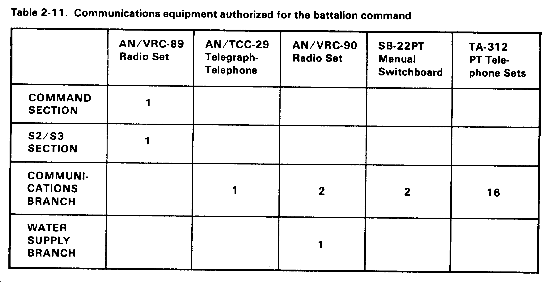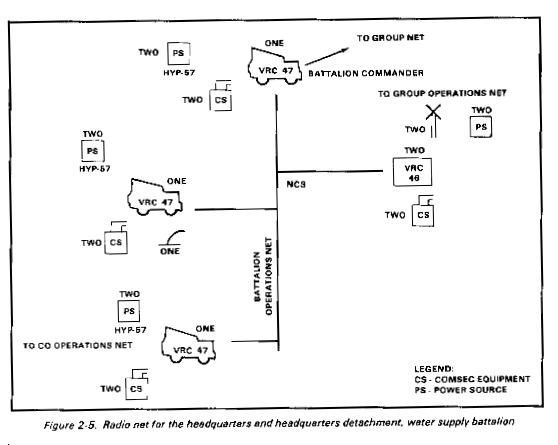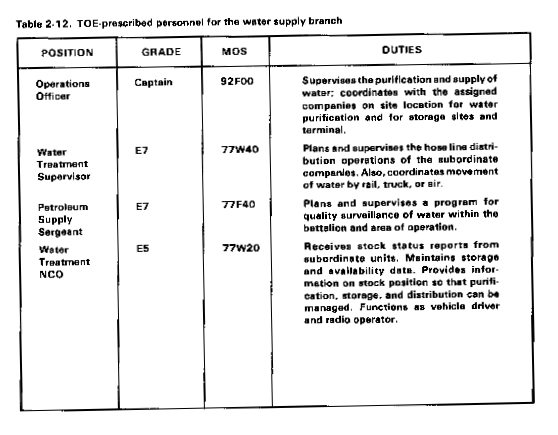|
CHAPTER 2 HEADQUARTERS AND HEADQUARTERS DETACHMENT, WATER SUPPLY BATTALION
|
Section I
HEADQUARTERS AND HEADQUARTERS DETACHMENT
This section is for the detachment commander.
MISSION AND ORGANIZATION
HHD, water supply battalion (TOE 10116*) is the headquarters and control agency for water units. The battalion provides command, administrative, technical, and organizational control for assigned or attached units. These units include water supply (TOE 10468) and transportation medium truck (water) (TOEs 55727 and (55728) companies. Water purification teams ((TOE 10570) will be attached when necessary. See Figure 2-1. The battalion is designed to meet mission requirements in arid environments. It will be employed in the corps or COMMZ near lines of communication. Battalion personnel plan and supervise the supply of potable water and coordinate efforts to operate and maintain the water distribution systems. The organizational structure provides for a battalion headquarters and a headquarters detachment. See Figure 2-2.
ASSIGNMENT AND ALLOCATION
The HHD is organic to the water supply battalion. The battalion is normally assigned to a petroleum group or a COSCOM. When no petroleum group is assigned to a major command, the battalion may be assigned to a TAACOM.
CAPABILITIES
At full strength (TOE Level 1), the HHD, water supply battalion may command and control from two to six water supply companies, TOE 10468L; water purification detachments, TOE 10469L; transportation medium truck (water) companies, TOEs 55727L and 55728L; and, as appropriate, water teams, TOE 10570. TOE Strength Level 2 reduces operational capabilities to about 90 percent. Strength Level 3 reduces capabilities to about 80 percent. The HHD can transport 18,500 pounds (1,416 cubic feet) of TOE equipment with organic vehicles. It has 7,782 pounds (438 cubic feet) of TOE equipment requiring transportation. It performs maintenance on organic equipment and communications-electronics equipment organic to assigned or attached units.
REQUIRED SUPPORT
This unit depends on the water supply company for maintenance support of equipment, except communications-electronics equipment. Mechanics are provided to augment the maintenance capabilities of the unit. Engineer organizations are responsible for finding surface water sources and sites on which to drill wells. Well-drilling teams that are organic or attached to nondivisional engineer units drill the wells. Engineers are responsible also for constructing and repairing rigid storage tanks and pipelines, making improvements at the water point site, and constructing and maintaining permanent and semipermanent water utilities at Army installations. Preventive medicine organizations approve water sources and provide routine surveillance to ensure water quality.
Section II
HEADQUARTERS DETACHMENT OPERATIONS
This section is for the detachment commander.
MISSION
The headquarters detachment provides administration, organizational supply, security, food service, and training activities. As detachment commander, you direct all battalion support activities.
PERSONNEL
Your most valuable resources are your soldiers. To use them effectively, you must know their duties. Table 2-1 lists TOE-prescribed personnel of your section by position, grade, MOS, and duties.
OPERATIONS
The detachment is the headquarters and control agency for units involved in water supply. Personnel in the detachment may command and control up to six units at Strength Level 1. Personnel in the detachment headquarters--
- Plan and supervise the supply of potable water and coordinate the efforts of the units.
- Maintain and support the water supply system so that personnel, equipment, and facilities are used to their best advantage.
- Control the supply of potable water through the water supply branch.
- Provide the technical and operational supervision for the battalion water purification, supply, and distribution functions through the S2/S3 section.
- Plan, control, and supervise the employment, deployment, security, and operation of the battalion, through the security and plans branch.
- Provide the communications systems for the battalion and the assigned units through its communications branch in the S2/S3 section.
SECTION III
BATTALION HEADQUARTERS OPERATIONS
This section is for the battalion commander.
MISSION
The battalion headquarters is the command and control element. The mission of battalion headquarters is to provide the necessary command and supervision of the technical operation of the battalion for its assigned and attached units. Command and control functions are performed through an arrangement of personnel, equipment, communications, facilities, and procedures. The designated personnel for the command section are the battalion commander and his immediate staff. The staff officers supervise the functions of the S1 section, the S2/S3 section, and the S4 section. Details on the S2/S3 section are described later in this chapter.
PERSONNEL
Your most valuable resources are your soldiers. To use them effectively, you must know their duties. Table 2-2 lists TOE-prescribed personnel of your section by position, grade, MOS, and duties.
COMMAND AND CONTROL
You are responsible for the mission of the battalion. You can delegate authority to your subordinates and make them responsible to you, but you are still responsible. The organization of the battalion headquarters elements is shown in Figure 2-2. The S2/S3 section is divided into a security and plans branch, a communications branch, and a water supply branch.
PREPARATION FOR MOVEMENT
The battalion must be ready to move at any time and by any means. When it moves within the theater of operations, the battalion most likely will use motor transport, but it may use air or water transport. One of the first things you should do after taking command is to see if the battalion has an SOP for moving. An SOP should cover--
- Plans for all types of movements, including means of getting vehicles, aircraft, or water transport.
- Plans for loading organic vehicles and other modes of transport which might be used.
- Instructions for conducting reconnaissance of the route to be traveled and the new site.
- Plans for displacing all or part of the battalion.
- Procedures for closing out operations at the old area.
- Plans for the march, such as feeding the troops, refueling vehicles, performing unit maintenance en route, and getting road clearances.
- Plans for defending the unit.
RECONNAISSANCE AND SITE SELECTION
After the COSCOM or TAACOM commander has assigned the general area, you or a reconnaissance team must check it out. The battalion S2/S3 usually takes charge of getting a team together and making arrangements for the reconnaissance. The team should include you, staff officers, the detachment commander and key personnel he selects, and personnel from the water supply branch.
Reconnaissance
There are several ways to check out the route and the new area. Sometimes map reconnaissance is the only way because of the lack of time or security. If there is no immediate danger from hostile forces and time is available, the reconnaissance team visits the area. Ground and map reconnaissance should be used. If available, aerial photographs should be used to aid in the reconnaissance process. Reconnaissance aids are field reports, geological maps, topographical maps, and aerial photographs.
Site Selection
The reconnaissance team should select an operating site and an alternate site for the battalion command post. The S2/S3 and the detachment commander select the general operating areas for the battalion and subordinate units. As a rule, the detachment headquarters commander is responsible for setting up the battalion command post. See FM 55-30 for help with motor movements and FMs 55-12 and 55-40 for air movements.
Section IV
S1 SECTION
This section is for the battalion S1.
MISSION
Under your supervision, the S1 section provides the necessary administrative and personnel management support required throughout the battalion. This section supervises correspondence and mail activities for the battalion. S1 section personnel prepare and provide to higher headquarters reports on casualties, strengths, and replacement requirements.
PERSONNEL
Your most valuable resources are your soldiers. To use them effectively, you must know their duties. Table 2-3 lists TOE-prescribed personnel of your section by position, grade, MOS, and duties.
ADMINISTRATIVE AND PERSONNEL MATTERS
The S1 section carries out the commander's policies on personnel administration. You supervise personnel management classification and assignment functions that relate to units attached to the battalion. You maintain liaison with the personnel service unit providing personnel service to the battalion that operates the automated SIDPERS. A personnel administration center will be established at the battalion level of command and tasked to provide formal administrative support to the unit. When this occurs, the commander still retains responsibility for the unit readiness posture of the unit and for ensuring that assigned soldiers are supported properly. He also retains responsibility for military justice and for informal administrative actions. See FM 12-3-1 and TCs 12-6 and 12-16 for more information on PAC. In support of the battalion commander, the S1 and the S1 section perform the following services.
Prepare Directives or Correspondence
Normally, unit personnel use handwritten notes or memos within the battalion. When unit commanders have correspondence which goes outside the battalion, PAC personnel type it in the correct format. Unit commanders send the PAC a handwritten draft of the information and instructions on what is needed--a letter, an endorsement, a DF, or a comment. Preprinted letters or forms may be used for repetitive actions. Policies may be set up to allow the S1 or the personnel staff NCO to sign for the commander when his signature is not required. AR 340-15 has information on how to determine signatory authority. It also contains guidelines for preparing correspondence.
Operate the Battalion Mail Service
You serve as the battalion postal officer to provide mail service to all battalion units. Unit commanders appoint a unit mail clerk to take mail from their unit to the battalion mail pickup point and receive mail to take back to their unit. Each mail clerk must have a DD Form 285 (Appointment of Military Postal Clerk, Unit Mail Clerk, or Mail Orderly). The PAC types these forms, gives one copy to the mail clerk, sends two copies to the AG postal division, and files one copy.
Maintain Unit Strength
The first sergeants, supervised by the unit commanders, send a personnel daily summary to the S1 section. The report includes authorized and actual strength figures, casualty reports, and administrative gains and losses of personnel. Once you receive the unit element reports, forward the information by secure means (radio, telephone, or courier) to the next higher headquarters. See TC 12-16 for more information on this. AR 600-8-1 and FM 12-15 cover casualty reports.
Administer Personnel Actions
Unit commanders may send oral or written requests for personnel actions through the personnel staff NCO. The personnel staff NCO within the PAC maintains liaison with unit commanders and their first sergeants. The requests may include reclassifications, promotions, reductions, separations, reassignments, reenlistments, and evaluations. Also, they may include routine administrative tasks such as requests for or preparation of mail cards, medical forms, identification cards and tags, clearance forms, and requests for leave, and family or financial counseling.
Provide Various Services
If soldiers need financial help, the unit commander or first sergeant coordinates with PAC to arrange for Army Community Service or other financial assistance agencies to help them. If unit personnel have problems with their pay account or need to make any changes to it, the PAC helps them or makes an appointment for them at the supporting finance activity. Recreational activities are provided in the unit area or rest areas (rest and recreation areas are in the rear area). Religious activities are conducted by the battalion chaplain.
Assist With Discipline, Law, and Order
You are directly concerned with discipline, law, and order in the battalion. You coordinate with the military police and the staff judge advocate who administers military justice for the COSCOM or TAACOM. AR 27-10 covers military justice, and AR 600-8-2 covers suspension actions. The PAC provides administrative support for the troops by--
- Preparing paperwork for the unit commanders' signatures.
- Preparing statements and forms for soldiers and arranging legal counsel for them.
- Forwarding documents through appropriate channels for action.
- Notifying unit commanders of actions taken by higher headquarters.
Prepare Reports
The PAC prepares or coordinates accident, readiness, casualty, strength, and evaluation reports and unit rosters. Accident reports are prepared on DA Form 285 (US Army Accident Investigation Report). Readiness reports are prepared on DA Form 2715-R (Unit Status Report). Procedures for preparing casualty reports are in FM 12-15. The division SOP, FM 101-5, and TC 12-6 give information on preparing strength reports. ARs 623-105 and 623-205 give the requirements for evaluation reports.
Prepare Orders
The administrative service division of the personnel service company issues written orders. It requests the issue of orders for personnel actions. Unit commanders may request the issue of other orders. The S1 tells the PAC what action is required and for whom. The PAC prepares a DA Form 2446 (Request for Orders) and sends it to the administrative service division. The PAC keeps a copy of the request until the orders are received. AR 310-10 has more on preparing military orders.
Section V
S2/S3 SECTION
This section is for the S2/S3.
MISSION
S2/S3 section personnel make sure the tactical mission of the battalion is carried out. The section supervises technical and military intelligence gathering and formulates plans. It is responsible for the training of the battalion units. This section is also responsible for the battalion operation order, the movement and location of battalion units, and rear operations. Its responsibilities also include the establishment and operation of the battalion wire net, radio net, and battalion communications center and the supplies and services provided to supported units.
PERSONNEL
The S2/S3 advises the battalion commander on operations, training, and intelligence. His responsibilities include selection of operational sites, coordination, and assignment of tasks. The S2/S3 is also the operations security officer. Table 2-4 lists TOE-prescribed personnel of the S2/S3 section by position, grade, MOS, and duties.
PLANS, COORDINATION, AND SUPERVISION
Soldiers in the S2/S3 section advise the battalion commander on the status of battalion operations, training, intelligence, and security. They also make sure that subordinate commanders understand and comply with battalion policies and directives in those areas. The S2/S3 section staffs all actions dealing with the supplies and services provided to supported units. Personnel in the S2/S3 section--
- Coordinate all services provided to supported units.
- Monitor motor transport operations and request additional support for battalion units where needed.
- Direct and supervise movement of battalion units.
- Supervise the gathering and processing of intelligence information.
- Coordinate rear operation plans and activities.
- Plan and supervise training of battalion units.
- Coordinate security and plans branch, communications branch, and water supply branch activities.
TRAINING
Army policy gives training responsibilities to the lowest level of command. The S2/S3 is the training coordinator for the battalion, and commanders and key NCOs are the trainers. The S2/S3 works with staff members and unit commanders to organize training plans for the battalion. Meetings are held regularly (preferably once a week) to determine unit missions and training needs. The commanders discuss the time needed for individual training and for collective training. The S2/S3 provides a schedule and all training and evaluation outlines needed to carry out training. There is no set format for the schedule. However, the schedule must include the mission and when and where the training is to be given. Also, it must include notes about training and evaluation outlines, other sources and references, and specific guidance. See FM 25-2 for further guidance in training management.
INTELLIGENCE
Intelligence and tactical operations functions in the water supply battalion are consolidated. The S2/S3 is responsible for major tasks in the area of intelligence. He is usually assisted by the operations sergeant and the security and plans NCO. Other members of the S2/S3 section give advice and information on intelligence, tactical operations, and security. S2/S3 section personnel maintain the operations map. The operations map is continuously updated to show the positions of all battalion units and all known friendly, allied, and enemy forces in the battalion area. Section personnel prepare the intelligence annex to the battalion SOP, the operation orders, and other necessary reports. They make data available to battalion units.
Estimate
Unit commanders must make it clear to their soldiers that any observations of enemy activity or attempted subversion, terrorism, or espionage must be reported without delay through command channels. The S2/S3 section receives information of intelligence value from battalion elements and sends it to the petroleum group S3 or to the COSCOM security, plans, and operations officer for appropriate action. In the event of an immediate security threat, the S2/S3 may mobilize forces for support. The intelligence estimate is a continuing requirement. Even though intelligence information may not be immediately important to the battalion or petroleum group, it may be important to other higher headquarters. FM 101-5 shows the type of information included in an intelligence estimate.
Operations
Tactical and logistic operations are of interest to higher headquarters. The S2/S3 reports enemy capabilities; areas that have become impassable due to mines, obstacles, or contamination; and the effects of weather and terrain. This information will be used to update the petroleum group or COSCOM situation map. Once higher headquarters processes the information, the S2/S3 section is provided with an intelligence report. The applicable portion of the report is forwarded by the S2/S3 section to battalion units.
This paragraph implementsSTANAG 2885 (Edition One). |
MOVEMENT AND LOCATION OF BATTALION UNITS
Once the S2/S3 receives an operation order, he tells the battalion units where they must locate and when they must begin operations. The following steps are taken:
- A warning order is issued to battalion elements to let them know a move is planned.
- A reconnaissance party is arranged to check the route and the new area. See Table 2-5 for a checklist for water reconnaissance. STANAG 2885 also has specific guidelines for water reconnaissance. See Table 2-6 for these guidelines.
- The operations NCO in the S2/S3 section coordinates with the petroleum group or COSCOM headquarters movement control officer to make sure transportation is available to support battalion operations.
- An advance party is organized and sent to the new area to clear the route of obstacles, to check for NBC contaminants, to post route markers, and to make hasty defense positions. The advance party also sets up the command post, lays communications wires from the command post to defensive positions and supply areas, and prepares the kitchen area.
REAR OPERATIONS CONSIDERATIONS
The S2/S3 coordinates with the battalion commander, other staff members, and company and detachment commanders to develop rear operations security plans and training for the battalion. The battalion may face a wide range of enemy actions. They vary from covert actions by enemy agents to full-scale attacks by battalions or large, enemy combat forces. Units in the rear must be prepared to respond to the various levels of threat. The levels are described in Table 1-5 in this manual. Defense information for the units within the battalion structure is presented throughout this FM.
COMMAND POST AND TACTICAL OPERATIONS CENTER
The S2/S3 manages the tactical mission operations from the TOC, which is the chief component of the battalion CP. In a built-up area, the CP may be in the same building with all of the battalion staff. A separate area of the building should be designated for the TOC. The CP may also be in tents. In this case, the S2/S3 should have a medium GP tent for the TOC with other staff members located next to it in small GP tents. See Figure 2-3 for suggested layout and staffing of a TOC.
Staff
Most of the time, the TOC has the battalion commander, the S2/S3, staff members, and communications soldiers. The TOC must be staffed and operated 24 hours a day. To do this, the S2/S3 may set up two 12-hour shifts. Usually, each shift has at least one officer, two NCOs, one clerk, and any liaison personnel needed. When the situation does not warrant a full staff, at least one person must be on duty at all times. In this case, the S2/S3 may have one fully staffed, 12-hour shift and an officer or NCO on duty for the next 12 hours. A duty roster is kept to rotate the duty officer and NCO detail. The operations sergeant can take care of these details.
Functions
TOC personnel receive reports from battalion units, requests for assistance from supported units, directives from higher headquarters, and other information pertinent to the mission. They keep the S2/S3 section informed and keep operations maps and charts posted with the latest information. Usually, the operations sergeant keeps the operations map up to date, and the security and plans NCO makes sure the latest information is on the situation map and the weather chart. Using the charts and maps provided, the S2/S3 or the battalion commander briefs staff officers and unit commanders regularly (usually daily). The commander decides how often. The communications chief is usually in charge of the net control station in the TOC. Other communications personnel may be located in a trailer, tent, or other structure next to the TOC to operate the wire net and to process messages.
Security
The TOC is a restricted area, so the S2/S3 must take precautions to keep it secure. The CP usually has protective wire or some other protective barrier around it. If the TOC needs more protection, the S2/S3 may request that wire or barriers be put around the TOC as well. A guard is posted at the entrance to the TOC. The detachment commander, who is responsible for CP security, assigns the guards. A roster of personnel who have access to the TOC is published and given to the guard. When a soldier needs to enter the TOC, the guard checks his identification card against the roster. After the initial check, the guard may admit him. If the soldier is not on the access roster, the guard asks the S2/S3 or one of the staff to see if he should be permitted to enter.
BATTALION WIRE AND RADIO NET OPERATIONS
Communication is an essential part of the battalion headquarters mission. The battalion commander, with the aid of the staff, receives and interprets plans, policies, and directives from higher headquarters. Communication between battalion units that is not routine is routed through the battalion commander. All available means of communication are used to ensure quick, accurate, and reliable dissemination of information. The S2/S3 has staff supervision of communications in a field or combat situation. More information on operations of the battalion communications branch is presented later in this chapter. The battalion communications chief runs the communications system and supervises other communications personnel. The system consists of single-channel radio nets and a mobile radiotelephone system augmented by multichannel tactical satellite radio. Maximum use is made of systems that soldiers can carry. The communications chief and soldiers accomplish the following functions.
Equipment
Communications personnel account for and maintain all the communications equipment belonging to the battalion. Battalion signal equipment includes FM radios; field telephones; switchboards; teletypewriters; terminal facilities; COMSEC devices; and auxiliary equipment, such as batteries, wire, and cables.
Net Control
Communications personnel establish the net control station for the battalion FM radio net. They monitor and control FM voice communication between battalion units using procedures given in FM 24-18 and the CEOI. The net controller opens and closes the net, imposes and lifts radio silence, ensures proper radio-telephone procedures are used, and keeps unauthorized stations from transmitting. Battalion radio net operations are described later in this chapter.
Teletype
Communications personnel provide teletype service to and from divisional units or, through the COSCOM support signal node, other telecommunication centers throughout the theater. This service is available to the headquarters detachment staff and the staff of subordinate units, as determined by the battalion commander. The telecommunications center is usually collocated with the message center.
Switchboard
The communications branch provides telephone and teletype switching service for all battalion elements. Switchboard operators manually connect battalion field phones and teletypes for intrabattalion communication. They use a connection to the COSCOM support signal node to allow voice communication to all theater elements.
FM Radio
Soldiers in the communications branch aid the commander by laying wires to all subordinate units and establishing an FM voice net. The branch is assisted by elements of the supporting signal battalion.
OPERATIONS REPORTS
The S2/S3 section prepares or processes mission operations reports and forwards them to the petroleum group or COSCOM security, plans, and operations section. The COSCOM, petroleum group, or TAACOM SOP should specify when the S2/S3 section submits its reports. These reports include the following:
- Intelligence spot report.
- Intelligence summary.
- Situation overlay.
- Ground surveillance plan.
- Air reconnaissance surveillance request.
Section VI
S4 Section
This section is for the S4.
MISSION
The S4 section is responsible for providing supply and maintenance services for the battalion organic and attached units. S4 section personnel, supervised by the S4, perform the following duties:
- Receive requests for expendable supplies from battalion units, enter them on the document register, and forward them to the supply management office.
- Monitor requests from battalion units for nonexpendable supplies.
- Monitor due-in expendable.
- Supervise turn-ins of supplies and equipment.
- Monitor unit maintenance operations.
- Monitor materiel readiness status of battalion units.
- Prepare logistics reports.
PERSONNEL
The S4 supervises internal supply and unit maintenance operations of battalion units. Coordination is made with the S2/S3 for planning area damage control measures. The S4 also serves as battalion materiel readiness officer. A battalion supply sergeant, two supply specialists, and one equipment repair supervisor assist the S4. Table 2-7 lists TOE-prescribed personnel of the S4 section by position, grade, MOS, and duties.
INTERNAL SUPPLY FUNCTIONS
Supplies and equipment must be available for battalion units when needed. The S4 must keep higher headquarters informed on the status of internal logistics. Major shortages of equipment or supplies which affect mission capability are the number one priority and should be reported through command channels immediately. The S4 initially gives the COSCOM staff advance notice of battalion requirements of supplies and equipment. The S4 bases requirements on the number of soldiers in the battalion, past demand experience, current requests, unit supply status reports, and the unit commanders' estimates of future needs. Battalion logistics may be divided into three general areas. They are described below.
Internal Supply
Internal supply is the provision of all classes of supply in support of battalion personnel, equipment, and operations, excluding those supplies which are passed on to supported units (mission stocks).
Field Services
Field services are provided to support battalion personnel and equipment. They include food service, water supply, bath, laundry, reimpregnation, clothing exchange, renovation, salvage, decontamination, and graves registration.
Maintenance
Maintenance includes inspection, repair, calibration, and modification of battalion equipment at the unit level.
UNIT SUPPLY FUNCTIONS
S4 section personnel help the S4 monitor the status of supply within the battalion and account for battalion property. Members of this section are trained and experienced in unit supply. They inspect supply rooms, dining facilities, arms rooms, and motor pools. They resolve any problems in favor of battalion, higher headquarters, and DA policy. The S4 knows how supplies are classified and how they are accounted for. Table 2-8 explains supply accounting terms. Items by classification are explained below.
Expendable Items
The unit supply sergeants send requests to the battalion S4 section. The section keeps a document register of requests for expendable items. Section personnel list each request on the document register and enter a document number on the request. Then the requests are sent to the supply management section.
Nonexpendable Items
The supply sergeant may prepare requests for nonexpendable items. The requests are forwarded to the property book team at the supply management section where document registers for these requests are kept. Battalion policy may require the supply sergeant to send the requests through the S4 for information only.
Durable Items
The supply sergeant sends requests to the battalion S4 section. The section keeps a document register for requests for durable items. Requests are listed on the document register, and a document number is entered on the requests. Then the requests are sent to the supply management section.
SUBORDINATE UNIT SUPPLY RECORDS
One of the missions of the S4 is to take care of the paperwork for the water supply battalion, which is consolidated at battalion level. This involves preparing and processing logistic reports and records, such as readiness-related reports; receipt, issue, and turn-in forms; and various property transactions and lists. For more detailed information, refer to FM 10-14-2.
MAINTENANCE
Unit maintenance is performed under the supervision of the S4. He is also the battalion materiel readiness officer. As part of his maintenance duties, the S4--
- Organizes maintenance operations as directed by the battalion commander. The water supply companies provide maintenance support for the battalion. The S4 and the battalion motor maintenance sergeant coordinate with the water supply companies to make sure support is provided.
- Helps select the areas for setting up vehicle maintenance and sees that areas are designated for other equipment maintenance.
- Inspects facilities and operations frequently to see that regulations and battalion policies are followed. He identifies problem areas and helps find solutions. FM 29-2 includes sample inspection checklists.
- Ensures that repair parts are requested according to regulation and that they are received promptly. Also, he checks to see that records are kept correctly. Ensures that liaison is kept with supporting maintenance activities. Copies of the supporting unit's SOP are given to the maintenance personnel so that they will use the correct procedures for requesting support.
- Gives maintenance training needs to the battalion S2/S3 so that they can be included in the battalion training schedule.
- Keeps the commander and the other staff members advised of the maintenance and materiel readiness situation.
REAR OPERATIONS PLANNING
The S4 plans and writes the SOP for area damage control. Coordination is made with the petroleum group, the COSCOM G4, the battalion S2/S3, and the unit commanders to ensure that plans are complete. Commanders should know what their units are responsible for and see that equipment and supplies are available.
MOVEMENT
The battalion S2/S3 is responsible for moving the battalion in the field. The S4 coordinates logistics support for the move and gives the S2/S3 whatever help is needed in preparing for the move.
SPECIAL MAINTENANCE TECHNIQUES
Special maintenance techniques with which staff members need to be familiar are the same as those taught to maintenance specialists. Training should include any special handling techniques required in the operational area, using the appropriate TMs and TCs. Supply and maintenance operations in the desert are described in FM 90-3, Chapter 5. Training should be modified according to the following:
- The MTOE and mission of the unit.
- The supply situation expected in the area of operations.
- The capabilities of logistic units likely to support unit operations. Special attention should be given to units not normally found in conventional operations (well-drilling teams and transportation truck companies, for example).
Section VII
SECURITY AND PLANS BRANCH
MISSION
This section is for the security and plans officer.
This branch plans, controls, and supervises the security, deployment, employment, training, and operation of the water supply battalion and its assigned or attached units. Branch personnel--
- Develop plans and supervise training of assigned and attached units.
- Develop and implement training programs for the headquarters and subordinate units.
- Develop and implement general educational development programs.
- Plan, direct, coordinate, and supervise intelligence, counterintelligence, and civil affairs programs.
- Develop and coordinate plans for security and defense of the headquarters and subordinate units.
PERSONNEL
Your most valuable resources are your soldiers. To use them effectively, you must know their duties. Table 2-9 lists TOE-prescribed personnel of your branch by position, grade, MOS, and duties.
OPERATIONS
This branch operates under the direct supervision of the S2/S3. Branch operations are similar to those of the S2/S3 section of the HHD. As security and plans officer, you--
- Develop policies and guidance for training.
- Evaluate training.
- Supervise intelligence, security, and defense activities.
- Prepare broad planning guidance, policies, and programs.
DEFENSE RESPONSIBILITIES
You are responsible for the security and defense of your personnel and equipment. Unlike combat units that are designed and equipped to fight the enemy, your unit is designed and equipped for its primary mission of providing command, administrative, technical, and operational supervision and control of the water production and distribution system. However, if you are attacked, your personnel must be able to defend themselves initially with the assets organic to the unit. You must develop a defense plan, assign specific duties, and ensure that your personnel are trained to perform defense tasks. You will need to develop your defense plan in conjunction with higher headquarters and adjacent units. See Chapter 1 in this FM for more information on defense.
Section VIII
COMMUNICATIONS BRANCH
This section is for the security and plans officer and communications officer.
MISSION
The communications branch provides teletype and telephone communication support for the battalion and detachment headquarters. It also operates the battalion communications center. Your mission requires you to provide wire, radio, and telegraph-telephone communications and switchboard, message center, and net control station services.
PERSONNEL
Your most valuable resources are your soldiers. To use them effectively, you must know their duties. Table 2-10 lists TOE-prescribed personnel of the communications branch by position, grade, MOS, and duties.
OPERATIONS
You are responsible for the communications for the group. You will need to know the wire net plan, the net control station, the switchboard, and the radio communications net as described below. You are responsible for allocating these assets. Equipment should be allocated as needed to perform the mission.
Wire Net Plan
TA-312PT telephone sets are dispersed throughout the battalion. Your personnel should develop a wire net plan that shows the location of these telephones. See FM 11-50 and FM 24-20. The plan should also identify the terminals to which each telephone is connected on the switchboard. The plan should show where the wire is buried underground or installed overhead. Designate a wire team to coordinate telephone installation with the supported units. Have the team identify manpower and equipment requirements. Figure 2-4 shows a diagram of the HHD wire net. Your section also installs and recovers field wire.
Radio Communications Net
See Table 2-11 for the communications equipment authorized the battalion command. A proposed wire net is shown in Figure 2-5. Your personnel should follow the guidelines in FM 21-3 when establishing the radio net.
Messenger
Use unit personnel as messengers as much as possible. They provide the most secure method of communication. They also help get needed supplies at once. You can call ahead to start the supply process, then send the paperwork with a messenger.
Net Control Station
The group NCS operates according to the procedures outlined in FM 24-18. Your personnel--
- Open and close the net.
- Control transmissions.
- Authenticate and clear traffic within the net.
- Direct the net.
- Correct errors in operating procedures.
- Give or deny permission for stations to enter or leave the net.
- Impose or lift listening silence.
- Maintain net discipline.
Switchboard Service
The battalion has two SB-22PT switchboards, which are assigned to your section. Personnel in your section operate them. They should use correct telephone procedures to answer, connect, and disconnect incoming calls and to place outgoing calls. The telephone communications system provides switchboard service on a 24-hour basis. Have your personnel update the switchboard traffic diagram as required. They should follow procedures outlined in FM 24-20.
Section IX
WATER SUPPLY BRANCH
This section is for the operations officer.
MISSION
The water supply branch provides technical and operational supervision for up to six water purification detachments. The branch also provides this guidance for water supply companies and transportation medium truck companies assigned to the water supply battalion.
PERSONNEL
Your most valuable resources are your soldiers. To use them effectively, you must know their duties. Table 2-12 lists TOE-prescribed personnel of your branch by position, grade, MOS, and duties.
COORDINATION OF COMPANIES AND TEAMS
You are responsible for dispatching operations. You also coordinate water purification and supply functions with the units described below.
Water Purification Detachment and Teams
The water purification detachment produces potable water within the theater. The teams augment DS water systems. The teams may also augment the water purification capability organic to supply and service companies. Water purification units normally operate out of base terminals, but they may locate at any large water source.
Water Supply Companies
These companies establish and operate bulk storage tank farms and tactical water distribution systems (see Chapter 3). Tank farms, or terminals, also provide water support for units nearby on a supply point basis. Tactical water distribution teams are assigned to water supply companies as required to augment capabilities for bulk distribution of water throughout theater army and corps areas.
Transportation Medium Truck Companies
These companies use collapsible fabric tanks mounted on standard cargo semitrailers to transport water. This capability is required early in the development of the theater. It serves as the main means of distribution, pending the emplacement of base terminals, tank farms, and tactical water distribution systems. As the theater matures and the mission changes, it serves as the only means of distributing water from corps area tank farms forward into divisional and brigade storage facilities.
OPERATIONS
You are responsible for organizing the branch so that it can function properly. You must monitor water operations in the battalion so that water supply will be adequate for all supported units. The operations are described below.
Purification, Storage, and Distribution
Purified water is pumped into the base terminal storage facility, consisting of collapsible tanks, from purification equipment located onshore and offshore. It is then distributed to other terminals within the theater army area and forward into the corps areas by tactical water distribution systems. Terminals also provide water on a supply point basis to units located nearby. Personnel move water forward from the corps areas by semitrailer mounted fabric tanks and distribute it to divisional and brigade support areas for issue. Large quantities of potable water under field conditions may be distributed by pipeline, hose line, semitrailer-mounted fabric tanks, and tank trucks. Smaller quantities will be picked up from storage and distribution points in tank trucks, water trailers, SMFTs, or 5-gallon water cans. In some situations, small quantities of water from the Forward Area Water Point Supply system may be delivered by aircraft.
Technical Support
Personnel in your branch must determine daily requirements and available storage space. They determine the quantity of water to be purified and stored at the various terminals. Also, they develop graphs for projected consumption and deliveries. Your branch personnel manage the water quality surveillance program and determine sampling and testing procedures for potable water supply according to TB Med 577. They determine reporting procedures for supported units. They establish and monitor the transportation, handling, and testing of bulk water supplies. Branch personnel identify sources of potential contamination and deterioration of water quality. They provide advisory technical assistance to military activities in the battalion area.
Records and Reports
Personnel from your branch receive operations reports from all purification and hose line units and storage terminals. The reports provide daily production, storage, and distribution data. These data are used in conjunction with a consumption graph and progress chart to coordinate water point operations, safeguard water quality, and improve water treatment and distribution. Blank copies of many of the forms used for these records and reports can be found in FM 10-52. The forms may be reproduced locally.
Pumping and distribution records. Daily production and distribution data must be recorded on the required logs. These daily records are sent by the purification and distribution units to your water inventory specialist. Use these data to make up a summary report. You should review both daily and summary reports to check the status of the operation of your units daily. Investigate any discrepancy.
Loading schedules. You can use the pumping and distribution schedules to develop loading schedules. First, determine the estimated requirements, availability of transportation, and the needs of the supported units. Then, develop loading schedules from these data.
Daily water point reports. The water point team chief submits daily reports on production and distribution of water. Since these reports are the basis for other water supply records, they should be filled out carefully.
Water quality reports. Representatives of the command surgeon routinely check water points. They use DA Form 5456-R (Water Point Inspection) to report their findings to higher headquarters. See TB Med 577. They check the chlorine content and pH of the water. They also inspect the sanitation of the water point. If they find a problem, they may recommend that you stop water production at once. They also take water samples to be checked for bacteria. Results are reported on DD Form 686 (Bacteriological Examination of Water). The form is sent to the headquarters of the unit providing the water. The tests provide a record of the potability of the water.
Summaries. The water point supervisor receives the daily production and distribution reports from the individual team chiefs. The supervisor compiles the data and sends the summaries to your branch.
*TOE 10116 is scheduled to be converted to TOE 10466L in the near future. This change occured after final preparations for printing this manual had been made.
|
NEWSLETTER
|
| Join the GlobalSecurity.org mailing list |
|
|
|



